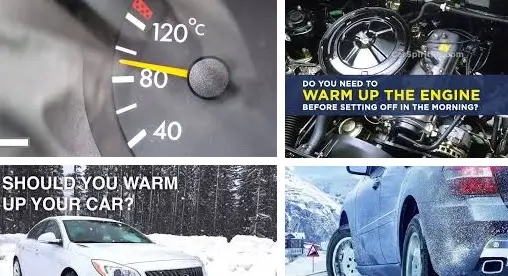To warm up your car, let it idle for about 30 seconds to a minute, then you can start driving. Warming up your car for longer periods of time is unnecessary and can waste fuel.
It is a common myth that your car needs to be warmed up for several minutes before driving, but modern engines are designed to be driven right away. So, to optimize fuel efficiency and reduce unnecessary idling, it is best to limit your warm-up time and start driving after a brief idle period.
This will also help your car engine reach its operating temperature more quickly, which is beneficial for overall performance and longevity.
Benefits Of Warming Up Your Car
Warming up your car before driving has several benefits. It allows the engine oil to warm up and circulate, improves fuel efficiency, reduces wear and tear on the engine, and provides better performance in cold weather. However, the ideal warm-up time can vary depending on the weather conditions, generally ranging from 30 seconds to a few minutes.
Always consult your car’s owner’s manual for specific recommendations.
Improved Engine Performance In Cold Weather
When the temperatures drop, your car’s engine can become stiff and sluggish. By allowing your car to warm up before driving, you improve its performance in cold weather. The engine oil becomes less viscous, allowing it to flow more freely and reach all the necessary engine components. This helps lubricate the moving parts, reducing wear and tear and ensuring optimal performance.
Better Fuel Combustion
Warming up your car before driving also aids in the process of fuel combustion. As the engine warms up, the fuel-air mixture becomes more evenly distributed, resulting in better combustion efficiency. This not only improves your car’s fuel economy but also reduces harmful emissions. By giving your car a few minutes to warm up, you can minimize fuel wastage and contribute to a cleaner environment.
Extends The Life Of Engine Components
Allowing your car to warm up before driving can significantly extend the life of its engine components. Starting a cold engine and immediately subjecting it to high RPMs can cause excessive wear on critical parts.
By giving the engine a chance to warm up, you allow the metal components to expand gradually and avoid sudden stress. This can prevent potential damage, reduce the risk of expensive repairs, and ultimately increase the lifespan of your engine.
Enhanced Safety By Ensuring Proper Functioning Of Lights And Windshield Wipers
Warming up your car not only benefits the engine but also ensures the proper functioning of essential safety features. Taking a few minutes to warm up your car allows the electrical system to reach its optimal operating temperature.
This ensures that your lights, including headlights and taillights, are at full brightness, increasing visibility on the road. Additionally, the windshield wipers become more effective in clearing away rain, snow, or debris, enhancing your safety while driving.
The Myth And The Fact: Warming Up Your Car
Warming up your car before driving is a common practice, but how long should you let it idle? The myth suggests a few minutes, but the fact is that modern engines only need about 30 seconds to warm up. So, save on fuel and reduce emissions by keeping your warm-up time short.
Myth: Allowing The Engine To Run For A Few Minutes Before Driving Improves Performance.
One of the most prevalent myths when it comes to starting your car in cold weather is the idea that letting it warm up for a few minutes before driving will improve its performance.
Many people believe that by idling the engine for a while, the oil will have a chance to circulate, the engine will warm up, and it will lead to better fuel economy, smoother running, and enhanced overall performance. However, this widely held belief is nothing more than a myth.
Contrary to popular belief, idling your car for an extended period before driving not only wastes fuel but also contributes to unnecessary engine wear and tear.
Letting your car idle for too long doesn’t allow the engine to reach its optimal operating temperature efficiently, causing incomplete combustion of fuel and oil diluted with unburned fuel. This can result in carbon buildup, decreased fuel efficiency, and an increased emission of pollutants into the environment.
Fact: Start The Engine And Let It Run For A Short Period To Circulate The Oil, Then Drive Gently To Warm Up The Engine.
So, what should you actually do when starting your car in cold weather? The fact is simple: you shouldn’t let your car idle for an extended period. Instead, you should start the engine and let it run for a short period, typically around 30 seconds to one minute, to allow the oil to circulate throughout the engine. After this initial warm-up, it’s best to start driving gently, gradually increasing the engine speed and load to warm it up further.
Driving your car gently not only helps to warm up the engine more effectively but also allows other components, such as the transmission and tires, to reach their optimal operating temperature.
It’s important to note that modern engines are designed to warm up quickly while driving, thanks to advancements in technology and improved materials used in engine construction.
In addition to saving fuel and reducing engine wear, driving gently from the start also benefits your overall driving experience and vehicle performance. By initiating the warm-up process through driving, you’ll have better control over your vehicle, enhanced traction, and improved braking performance from the moment you start driving.
The Ideal Warm-up Time For Your Car
When it comes to starting your car on a chilly morning, you may have heard conflicting advice about how long you should let it warm up. Some say a few minutes is enough, while others recommend letting it idle for a longer period. So, what’s the ideal warm-up time for your car?
Understanding The Basics Of Engine Warm-up Time
Before we dive into determining the ideal warm-up time, it’s important to understand the basics of engine warm-up. When your car has been sitting overnight, the engine oil settles and becomes thicker, making it less effective at lubricating the engine components.
The fuel mixture may not be optimal when the engine is cold, which can affect its efficiency. The purpose of warming up your car is to ensure that the oil has had enough time to circulate and lubricate the engine, and to allow the fuel mixture to reach the ideal balance.
Factors To Consider, Such As Outside Temperature And Engine Type
The ideal warm-up time for your car can vary depending on a few factors, including the outside temperature and the type of engine your car has.
Outside Temperature: Cold weather affects the time it takes for your engine to warm up. In extremely cold temperatures, it may take longer for the engine to reach its optimal operating temperature.
Engine Type: Different engine types may have different warm-up requirements. For example, older carbureted engines may require a longer warm-up period compared to modern fuel-injected engines.
Recommended Warm-up Times For Different Weather Conditions
To help you determine the ideal warm-up time for your car, here are some general guidelines based on different weather conditions:
| Weather Condition | Recommended Warm-Up Time |
|---|---|
| Below freezing (0°F or lower) | 3 to 5 minutes |
| Cold (20-32°F) | 1 to 3 minutes |
| Cool (33-50°F) | 30 seconds to 1 minute |
| Mild (50-70°F) | No warm-up necessary |
Keep in mind that these are general recommendations and may vary depending on your specific car and driving conditions. It’s always a good idea to consult your car’s owner manual for any specific warm-up instructions provided by the manufacturer.
In conclusion, while it’s important to let your car warm up to ensure optimal performance, excessively long warm-up times are unnecessary and can contribute to unnecessary fuel consumption and engine wear.
By following these guidelines and considering the outside temperature and engine type, you can determine the ideal warm-up time for your car and start your day off on the right track.

Dispelling Common Myths About Engine Warm-up
Dispelling Common Myths about Engine Warm-Up: Wondering how long you should let your car warm up before driving? Contrary to popular belief, there’s no need to let your engine run for several minutes to improve performance, especially in cold weather.
Simply start the engine and go.
Analyzing The Belief That Longer Warm-up Times Are Always Better
One common misconception about warming up your car’s engine is that longer warm-up times are always better. Many people believe that allowing their car to idle and warm up for an extended period will result in better performance, especially in cold weather. However, this belief is not entirely true.
While it is important to let your car’s engine reach its optimal operating temperature before driving, excessively long warm-up times are unnecessary and can actually be detrimental to both fuel efficiency and engine health. Modern engines are designed to warm up quickly and efficiently, and idling for an extended period is not only wasteful but can also cause carbon buildup in the engine.
Addressing Misconceptions About Idling And Fuel Consumption
Another myth surrounding engine warm-up is the idea that idling your car for an extended period before driving saves fuel. However, this is not the case. In fact, idling your car consumes fuel without providing any significant benefits.
Studies have shown that most cars reach their optimal fuel efficiency within 30 seconds to one minute of starting. Therefore, idling your car for longer periods not only wastes fuel but also contributes to unnecessary emissions. Instead of idling, it is more fuel-efficient to drive the car gently to warm up the engine, especially in milder climates.
Separating Myths From Facts Regarding Engine Wear And Tear
There are several misconceptions about engine wear and tear in relation to warm-up times. Some believe that letting the car warm up for an extended period prevents engine damage. However, this belief is unfounded.
Modern engines are designed with advanced lubrication systems that allow them to reach optimal operating conditions quickly. Short warm-up times have been proven to have no adverse effects on engine durability. Additionally, prolonged idling can lead to oil dilution, which can increase engine wear.
It is important to note that in extremely cold weather conditions, a slightly longer warm-up time may be required, but even then, it is recommended to keep warm-up times to a minimum to ensure fuel efficiency and reduce unnecessary wear and tear.
Alternatives To Traditional Warm-up Methods
Discover the alternatives to traditional warm-up methods for your car. Learn how long you should let your car warm up before driving and the benefits of warming up your engine in cold weather. Find out if you really need to let your car warm up before driving in winter.
Modern Engine Technologies That Eliminate The Need For Long Warm-up Times
Modern car engines are designed with advanced technologies that minimize the need for long warm-up times. These engines employ features such as electronic fuel injection systems and sensors that optimize the fuel-air mixture for efficient combustion. As a result, the engine can reach its optimal operating temperature faster, reducing the warm-up time needed before driving.
Preheating Options Like Engine Block Heaters And Electric Coolant Heaters
To alleviate the need for extended warm-up times, car owners can consider preheating options such as engine block heaters and electric coolant heaters. Engine block heaters are installed in the engine compartment and warm the engine oil, ensuring proper lubrication and reducing wear during startup.
Electric coolant heaters, on the other hand, keep the coolant warm, allowing the engine to reach its operating temperature more quickly. Both options help to minimize cold-start wear and increase fuel efficiency.
Tips For Driving Gently In The Initial Stages To Warm Up The Engine
While modern engine technologies and preheating options are effective, there are still instances where drivers may need to warm up their engines before driving. In such cases, it is recommended to follow these tips for driving gently in the initial stages:
- Start the engine and let it idle for no more than a minute or two. This allows the oil to circulate and reach optimal viscosity.
- Avoid harsh acceleration and high RPMs in the first few minutes. Gradually increase speed and RPMs as the engine warms up.
- Keep the load on the engine light during the warm-up period. Avoid towing or carrying heavy loads until the engine is at its operating temperature.
- Pay attention to the engine temperature gauge. Once it reaches the normal operating range, it indicates that the engine is sufficiently warmed up and ready for regular driving.
By following these tips, drivers can ensure their engine warms up quickly and efficiently without unnecessary idling, reducing fuel consumption and emissions.
Frequently Asked Questions Of How Long Should You Let Your Car Warm Up?
How Long Should You Let Your Car Warm Up Before Driving?
It is recommended to let your car warm up for about 30 seconds to a minute before driving. This allows the engine to reach its optimal operating temperature and ensures proper lubrication of the components.
Is It Necessary To Warm Up Your Car In The Winter?
In modern cars, it is not necessary to warm up your car for an extended period in the winter. Just a few minutes of idling is enough to get the oil flowing and ensure smooth operation.
What Are The Benefits Of Warming Up Your Car?
Warming up your car in cold weather helps to improve the performance of the engine and allows the heater to blow warm air sooner. It also reduces wear and tear on the engine by allowing the oil to circulate properly.
Does Warming Up Your Car Waste Fuel?
Yes, idling your car to warm it up can waste fuel. It is recommended to limit the warm-up time to a few minutes and then drive gently to warm up the engine faster and save fuel.
Conclusion
The length of time you should let your car warm up before driving depends on several factors, including the temperature outside and the age of your vehicle. While it’s no longer necessary to let your car idle for long periods of time, it’s always a good idea to give it a few minutes to warm up before hitting the road.
This allows the engine oil to circulate and the internal components to reach optimal operating temperatures. Remember to check your manufacturer’s recommendations and use your judgment based on the conditions. Take care of your car, and it will take care of you.
Stay safe on the road!


Leave a Reply